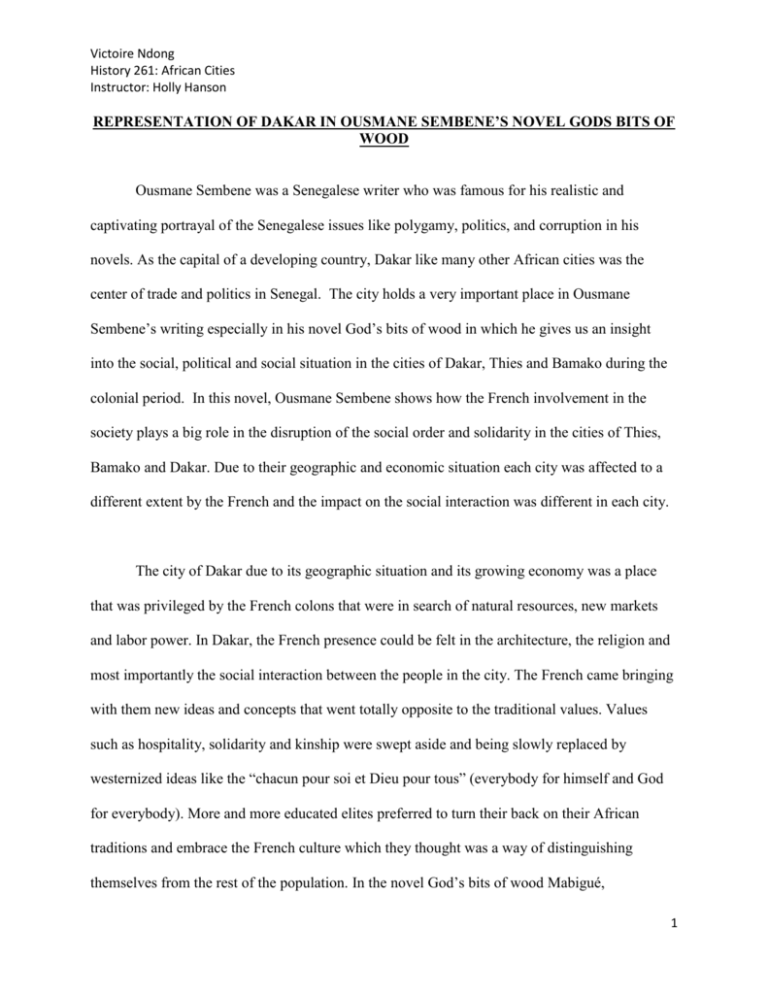Ousmane Sembene.doc
advertisement

Victoire Ndong History 261: African Cities Instructor: Holly Hanson REPRESENTATION OF DAKAR IN OUSMANE SEMBENE’S NOVEL GODS BITS OF WOOD Ousmane Sembene was a Senegalese writer who was famous for his realistic and captivating portrayal of the Senegalese issues like polygamy, politics, and corruption in his novels. As the capital of a developing country, Dakar like many other African cities was the center of trade and politics in Senegal. The city holds a very important place in Ousmane Sembene’s writing especially in his novel God’s bits of wood in which he gives us an insight into the social, political and social situation in the cities of Dakar, Thies and Bamako during the colonial period. In this novel, Ousmane Sembene shows how the French involvement in the society plays a big role in the disruption of the social order and solidarity in the cities of Thies, Bamako and Dakar. Due to their geographic and economic situation each city was affected to a different extent by the French and the impact on the social interaction was different in each city. The city of Dakar due to its geographic situation and its growing economy was a place that was privileged by the French colons that were in search of natural resources, new markets and labor power. In Dakar, the French presence could be felt in the architecture, the religion and most importantly the social interaction between the people in the city. The French came bringing with them new ideas and concepts that went totally opposite to the traditional values. Values such as hospitality, solidarity and kinship were swept aside and being slowly replaced by westernized ideas like the “chacun pour soi et Dieu pour tous” (everybody for himself and God for everybody). More and more educated elites preferred to turn their back on their African traditions and embrace the French culture which they thought was a way of distinguishing themselves from the rest of the population. In the novel God’s bits of wood Mabigué, 1 Victoire Ndong History 261: African Cities Instructor: Holly Hanson Ramatoulaye’s brother, is a perfect example of the new Dakarois created by the French: self centered, snob towards his people and partner of the French in any situation. The avidity of power and greed pushed the elites towards helping the French more than being helpful to their people. However, despite the egotism that existed among the higher classes, the ordinary people, like the women in the Ndiayene’s compound kept helping each other and supporting each other in the name of the values they shared; values like sharing everything no matter the situation, standing by each other like when Ramatoulaye killed the ram and being hospitable. Ndeye Touti because of the French education she received also thought she was better and more civilized than the rest of her family. She spoke French a lot and was more drawn to going to the movies and reading novels than helping her family. The strike brought the poor people together and widened the gap between poor and elite, each taking side for the French or their countrymates. The Muslim dignitaries were using their religious power to reinforce the French rule and force people to cooperate with them “God has decided that we should live side by side with the French toubabs, and the French are showing us things we have not known and showing us how to make the things we need. It is not up to us to rebel against the will of God, even when the reasons for that will are mystery to us”. In the other city Thies, there was less French and the main reason for their presence was that the railroad passed by there. In Thies, people are much closer than in Dakar and there is more uniformity in the decisions they make. The reason for that maybe that it’s a much smaller city but the main reason is that the French presence was not as big as in Dakar. There are not many elites in Thies people have almost all the same status and there were no dignitaries favored by the French causing jealousy among the people. When Maimouna the blind woman lost her child, she was received in the house of Dieynaba who was also helping the people wounded 2 Victoire Ndong History 261: African Cities Instructor: Holly Hanson during the strike. People from Thies were more worried about the common well being than individual benefits. The contrast between Dakar and Thies can be seen in how they react to death. In Thies, when the two boys Séne and ka (page 162) were shot, the population mobilized to fight back; there were a lot of people that went into the streets to protest: “Men, women, children flowed into the streets by the hundreds marching towards the railroad yards”, “On their faces, hunger, sleeplessness, pain, and fear had graven into the single image of anger” page 163. In Dakar on the opposite, when Houdia Mbaye died the people calmed down instead of rebelling more. The fear of the French and the lack of support from important people like the Grand Serigne of N’dakarou and Mabigué made them stay quiet in their anger: “As if the suddenness of death had calmed their anger, the women just stood where they were or gathered in little whispering groups”, “No one knew what to do next”; page 123. Bamako unlike Thies and Dakar is a city that is more into traditions and kinship. Like in Thies, there were not many French people; mostly because in Bamako there was no coast where French people could do imports and exports and the city was more into the continent. The French in their fear of illnesses never wanted to go very deep into the continent. People from Bamako in search for jobs used to migrate to Dakar and other Senegalese cities where there were more job opportunities. In Bamako, the French presence was barely felt. The people kept having their town meeting just like they did before to discuss the issues. They tried the people that were accused of betrayal themselves and the social order was almost the same as during the precolonial times and older people were shown a lot of respect due to their experience “Mamadou Keita, or the old one, as he was respectfully known, was standing at the left of the stage”. The architecture was the same: “At the center of the belt of hills the groups of mud walled houses and the dry grass, still scorched by the heat of noon, now swam in the red waters of the setting sun”. 3 Victoire Ndong History 261: African Cities Instructor: Holly Hanson Out of the three cities, Bamako is the one that has kept more of its traditional integrity and people are loyal to each other. That is because the social order was preserved and no matter the problems that can shake the city, the old dignitaries and the chiefs that are responsible for making the decisions will stay together. People like Mamadou Keita were respected and were partial to their own people unlike Mabigué and the other who were more drawn to the money and power the French were offering them. In the three cities we can see that the extent to which the French are involved defines the kind of social interactions that exist between people. In the city they are more involved Dakar, we can see that there is a feud between the self-centered elites and the ordinary people that have no influence at all. In other cities like Thies and Bamako where the presence of the French is less visible, people tend to be more helpful to each other and the traditional values still persist. The new values brought by the French clash with what the people believe in and the famine helped bring the people together but it also helped widen the gap between the rich elites and the other Dakarois. EXCERPTS Sembene Ousmane: God’s bits of wood (published in 1962 Page 2: Niakoro talking about Senegal and her son who started the strike- “She had been told enough about this Senegal, about the work to be found there, the fortunes to be made, but she had brought back only mourning and sorrow…..when she spoke of her younger 4 Victoire Ndong History 261: African Cities Instructor: Holly Hanson son she said ‘He seems like one of the Ouolof people, one of the westerners; he has the bearing and the manners’” Page 40-41: This is the description of the Djouma place it shows the influence of Islam on the architecture - “She turned to the left and entered the Place de Djouma, a vast stretch of hard- packed sand dominated by the mass of the cathedral-mosque. The crescents atop its twin minaret glittered fiercely in the sun, pointing the sky”. Page 50: The Ndiayene’s compound: “The compound that was known as N’diayene, the motherhouse of Ramatoulaye, and all her progeny and family, centered around a shedlike structure, painted the color of earth and standing on a foundation of bricks. Page 63: This passage shows the influence of the French in the language. N’deye is talking to Beaugosse: “Have you noticed that in the whole time we have been talking we haven’t spoken a single word in Ouolof?” Page 68: This shows the solidarity among the people “Providence has indeed been kind… but everyone must have his proper share. Send the children and fetch all the water you can because there is none here. Empty everything you have- we will need lots of water. We will boil the meat and that way there will be both food and drink.” Page 124: In this passage, the corrupt Muslim dignitaries are trying to convince the people to stop the strike and work with the French: “God has decided that we should live side by side with the French toubabs, and the French are teaching us things we have not known and showing us how to make the things we need. It is not up to us to rebel against the will of God, even when the reasons for that will are a mystery to us”. Page 206: Same as the previous passage the Imam of Dakar is speaking to the crowd: “By ourselves we are incapable of creating any sort of useful object, not even a needle and yet 5 Victoire Ndong History 261: African Cities Instructor: Holly Hanson you want to strike against the toubab, who has brought us all these things! It is madness! You would do better thanking God for having brought them among us and bettering our lives with the benefits of their civilizations and their sciences” Additional instructor's comments about your submission Victoire, this is a very interesting essay, and you have touched on some of the aspects of the way Sembene portrays Dakar. But I think there is much more going on in the novel than your paper actually portrays. I think the selections you have chosen actually show more than the paragraphs of your paper show: that Sembene shows Dakar as the place where a self-centered elite's new values clash with the solidarity demonstrated by the families experiencing famine induced by the strike. Is Dakar the location of the public event that follows the march (I can't remember and I don't have a copy of the novel here in my office). Your paper needs to have a more forceful argument that is presented in the first paragraph, that each following paragraph develops. The American style of academic writing in somewhat different than the French style, but it is worth learning, as it will help you while you are here. If you are interested, you can come talk to me about this paper and we can discuss what your real argument is, and how you could make it more clearly. I have made some comments on a printed copy of your paper which I will bring to class on Monday. 6






![What[2]](http://s3.studylib.net/store/data/007901576_2-b2a1bf687d7f47659e077b9433e882ae-300x300.png)
